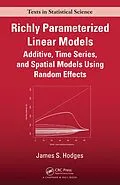A First Step toward a Unified Theory of Richly Parameterized Linear ModelsUsing mixed linear models to analyze data often leads to results that are mysterious, inconvenient, or wrong. Further compounding the problem, statisticians lack a cohesive resource to acquire a systematic, theory-based understanding of models with random effects.Richly Param
Autorentext
James S. Hodges
Inhalt
Mixed Linear Models: Syntax, Theory, and Methods: An Opinionated Survey of Methods for Mixed Linear Models. Two More Tools: Alternative Formulation, Measures of Complexity. Richly Parameterized Models as Mixed Linear Models: Penalized Splines as Mixed Linear Models. Additive Models and Models with Interactions. Spatial Models as Mixed Linear Models. Time-Series Models as Mixed Linear Models. Two Other Syntaxes for Richly Parameterized Models. From Linear Models to Richly Parameterized Models: Mean Structure: Adapting Diagnostics from Linear Models. Puzzles from Analyzing Real Datasets. A Random Effect Competing with a Fixed Effect. Differential Shrinkage. Competition between Random Effects. Random Effects Old and New. Beyond Linear Models: Variance Structure: Mysterious, Inconvenient, or Wrong Results from Real Datasets. Re-Expressing the Restricted Likelihood: Two-Variance Models. Exploring the Restricted Likelihood for Two-Variance Models. Extending the Re-Expressed Restricted Likelihood. Zero Variance Estimates. Multiple Maxima in the Restricted Likelihood and Posterior.
